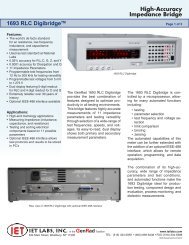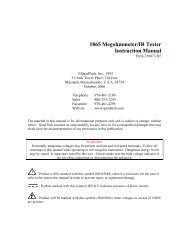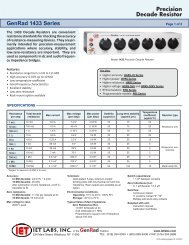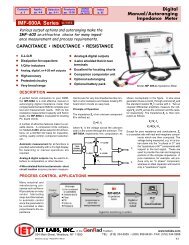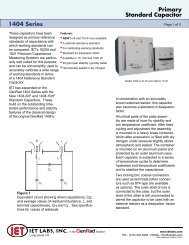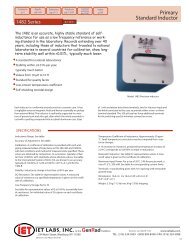Handbook of High Speed Photography - IET Labs, Inc.
Handbook of High Speed Photography - IET Labs, Inc.
Handbook of High Speed Photography - IET Labs, Inc.
Create successful ePaper yourself
Turn your PDF publications into a flip-book with our unique Google optimized e-Paper software.
SYNC<br />
GRIS3I<br />
STROBOTAC<br />
ELECTRONIC<br />
STROBOSCOPE »l<br />
GRI53I<br />
GR 1531<br />
»3<br />
GR 1531<br />
«4<br />
DEVICE<br />
)IN OUT <<br />
GR I53I-P-1<br />
CABLE<br />
GRI53I-P-*<br />
CABLE<br />
GRI53I-P4<br />
CABLE<br />
GRI53I-P4<br />
CABLE<br />
> IN O OUT<br />
UN<br />
OOUT<br />
GR 1531 -P2<br />
FLASH DELAY<br />
UNIT<br />
GR 1531 -P2<br />
FLASH DELAY<br />
UNIT<br />
GR 1531 -P2<br />
FLASH DELAY<br />
UNIT<br />
Figure 5-13. System for generation <strong>of</strong> a multiflash burst.<br />
All Flash Delay units are adjusted for equal delay.<br />
Since the Flash Delay is uncalibrated, an oscilloscope with a cali<br />
brated time base or some other precise timing device will be needed if<br />
it is necessary to flash the strobes at precisely timed intervals. If<br />
minimum delay between flashes is desired, the stroboscopes may be<br />
connected to each other directly. The General Radio line <strong>of</strong> strobo<br />
scopes may be interconnected directly via special cables provided as<br />
accessories for the various instruments. Table 5-1 indicates what con<br />
nectors are required for all possible interconnections.<br />
5.4 TAKING A TYPICAL HIGH<br />
SPEED PHOTOGRAPH.<br />
To summarize and illustrate<br />
the complete process <strong>of</strong> taking a<br />
picture <strong>of</strong> a high-speed event, here<br />
is a typical industrial situation: a<br />
photograph <strong>of</strong> the spindle (Figure<br />
5-14) <strong>of</strong> a "false-twist" textile ma<br />
chine is to be made to study the<br />
yarn as it passes around the trans<br />
verse (horizontal) pin. The spindle,<br />
which is 3/16 inches in diameter,<br />
rotates at the rate <strong>of</strong> 250,000 rpm.<br />
Figure 5-14. 3/16"-diameter<br />
spindle <strong>of</strong> "false-twist"-<br />
textile-machine. <strong>Speed</strong>,<br />
250,000 rpm.<br />
The required equipment is shown in Figure 5-15. A photoelectric<br />
pick<strong>of</strong>f is employed because <strong>of</strong> the high speed and low mass <strong>of</strong> the<br />
subject. The Flash Delay Unit powers the photo pick<strong>of</strong>f and permits<br />
single-flash exposure at any desired position <strong>of</strong> the spindle rotation.<br />
The second strobe, shown slaved to the first, may be used to increase<br />
the total available light and to render a more balanced exposure. A<br />
4X5 press camera with a 150-mm lens and 18-inch bellows extension<br />
capability is used so that Polaroid test pictures and negatives may be<br />
55












